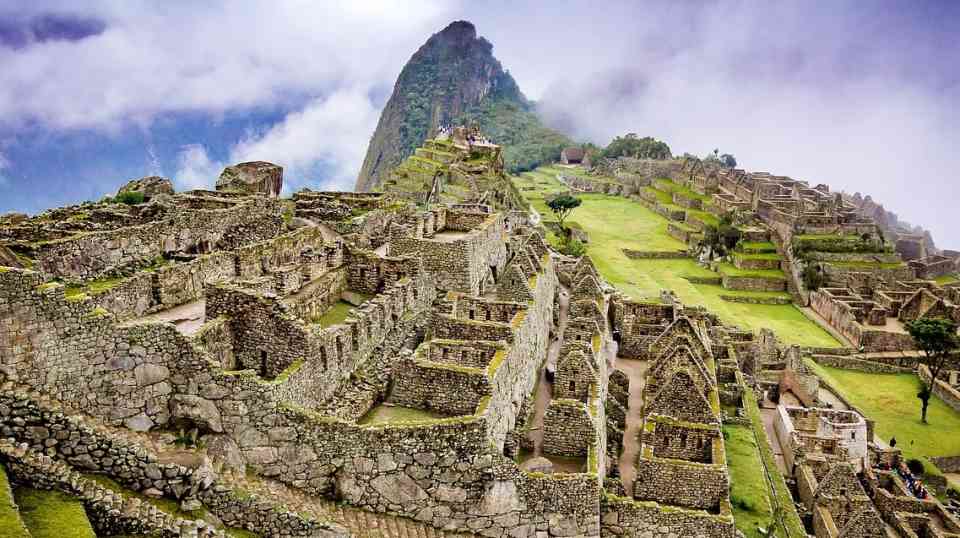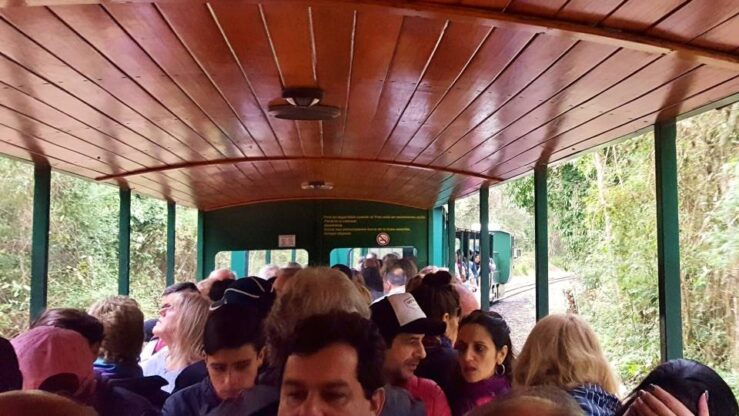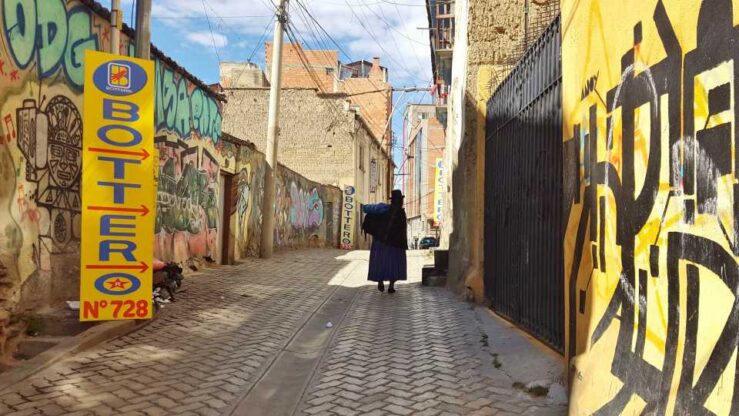See the Mythic Inca Culture on Machu Picchu Mountain
Part 2 of our 2-day tour to the Machu Picchu mountain – Read part 1
After visiting the Inca ruins of Ollantaytambo, Henry takes us to the train station where we say goodbye to our fabulous driver. It is by the end of the first day, where we have visited the Sacred Valley and the spectacular remains of the Inca culture, on our 2-day tour to the Machu Picchu mountain.
We are deeply impressed how much Inca culture our tour operator has been able to squeeze into this 2-day tour – still leaving us with time at each location to walk around at our own pace to explore.
We have tickets for the regular tourist Machu Picchu train from Ollantaytambo to Aguas Calientes, the town at the foot of the Machu Picchu mountain. Even if we have not chosen the most expensive tickets, for the Vista Dome or Hiram Bingham trains, our tickets for the Machu Picchu tour are definitely not cheap. Only Peruvians can benefit from another local train with reasonably priced tickets, but that train does not allow foreigners. There is a strict control with people’s identity, and Henry notifies us that we must show our passports when entering our train.
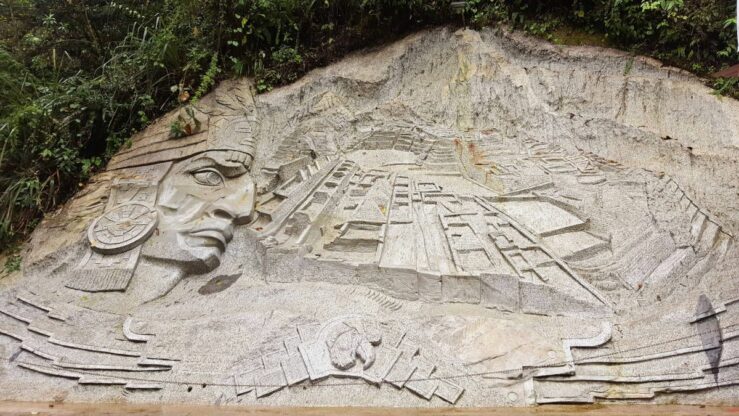
Introduction to Machu Picchu and the Inca culture | Photo: Travel In Culture
Crime rate Peru/your country
McMeal price Peru/your country
Road safety Peru/your country
We take our hand luggage sized backpacks out of the van and walk through the station to the platform where the Machu Picchu train arrives. As advised by the tour operator, we have taken as little as possible with us for the Machu Picchu trip, leaving the rest of our luggage behind at our hotel in Cusco.
It is without doubt the strictest train boarding procedure we have ever tried. Our reservation number is checked on a list with our passport details which we submitted way back – half a year ago! If your name, reservation number and passport number are inconsistent, you will be denied admittance to the train (and hence to Machu Picchu). This is seemingly how they keep track of the number of people going to Machu Picchu! The train staff even keep your paper reservation, and you will need to memorise your seat number to find your reserved seat, once on the Machu Picchu train!
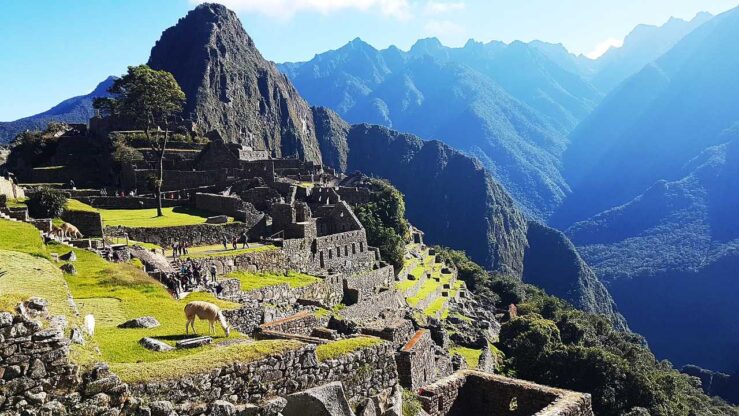
Machu Picchu | Photo: Mlproject / Pixabay
As there is no road between Ollantaytambo and Aguas Calientes, there are only few alternative ways to get to Machu Picchu. Some people hike the Inca trail, which is by the way not either any budget solution. The only other alternative to the train from Ollantaytambo is to make a long detour by car of maybe 6 hours, according to our guide. You then arrive from the other side of the mountain at the station Hydro Electrica. From here you will have to walk for a couple of hours along the rails, which to the best of our knowledge is not completely ‘legal’. Nevertheless, due to the lower costs, it is a popular option for backpackers.
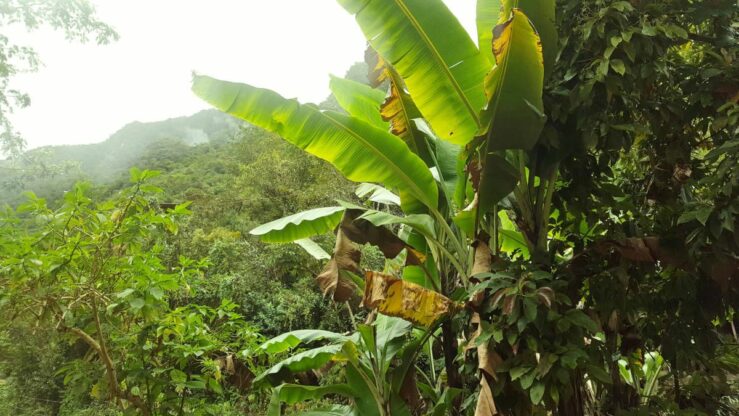
Machu Picchu rainforest | Photo: Travel In Culture
We are told that the Peruvian government easily could decide and undertake road constructions to Aguas Calientes. That would make it so much cheaper to get to the Inca citadel. However, it does not happen since this would remove the revenues from the valuable tourist train tickets. The Peruvian government is not at all interested in that, since it today is an indispensable contribution to the state economy.
The Machu Picchu train snakes through the picturesque Urubamba Valley, along the river and lush rainforest. On the way we pass one of these coal-fired trains uniquely dedicated to the Peruvian passengers. It is pretty packed. At 9 p.m., after a couple of hours on the train, which is gradually pulling slowlier through the mountains, we finally reach Aguas Calientes. The town is named after the hot springs where it is perfectly possible, still today, to get a well-deserved bath after a maybe exhausting trip or demanding hike to the Inca citadel.
Aguas Calientes is a somewhat funny place. Arising only due to the discovery of Machu Picchu and the need for a base at the foot of it, it is a village which is today nearly 100% dedicated to the Inca culture and tourism, tours and activities around the Machu Picchu mountain.
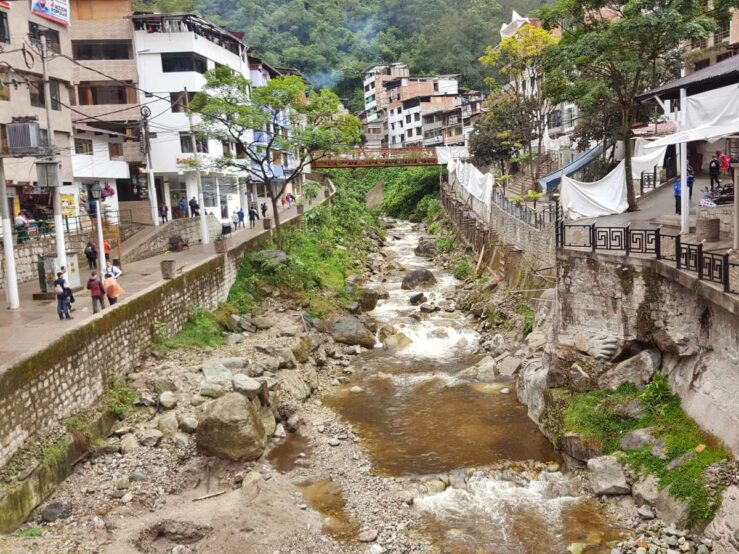
Aguas Calientes River | Photo: Travel In Culture
An indoor handicraft market, restaurants offering tourist menus, convenient hostels and hotels, as well as the thermal baths, make up the village altogether. We are surprised to see the streets bustling with people at this time of the evening – in such a small, isolated place! Apparently it is crowded whenever you come since there are always tourists for Machu Picchu, although the dry season (May – October) probably is more popular than the rest of the year.
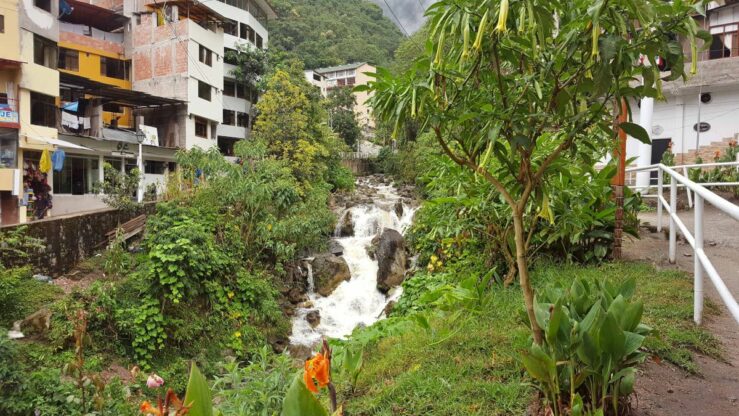
Lush riverside in Aguas Calientes | Photo: Travel In Culture
Henry, our guide for the 2-day tour to Machu Picchu, now takes us to our hotel and leaves us there for a few hours of merited rest. To our delight there is hot water in the shower, something we have not been too used to during our last weeks in Ecuador and Peru.
Early next morning we take one of the buses going up the slightly scary, hairpin road to the top of the mountain. We agree that it was the right decision not to hike all the way up – as some do! When we catch a glimpse of the hikers along the bends of the winding road, it really looks too demanding! The elevation of Machu Picchu archaeological site is ‘only’ 2,430 metres (7,972 feet) which is far below the elevation of Cusco (3,400 metres or 11,200 feet). This means that you, contrary to what many visitors think, are not as exposed to altitude sickness at Machu Picchu as for example in Cusco.
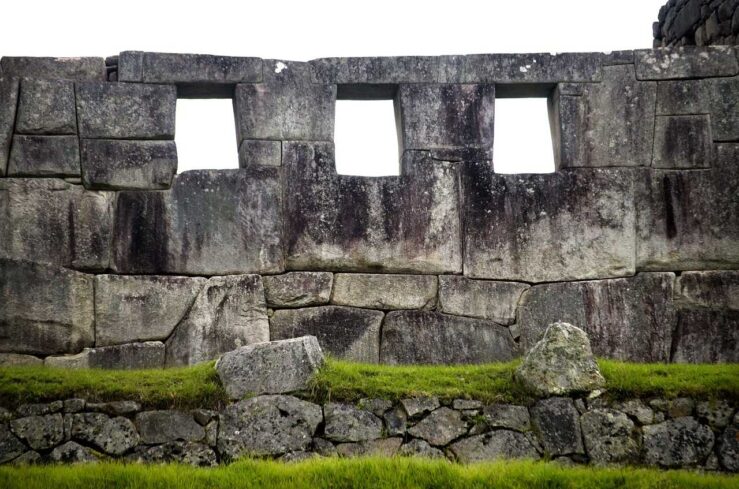
Inca culture and architecture | Photo: Carlos Chirinos / Pixabay
Reaching Machu Picchu, we are now in the Amazon rainforest. Here the mountainous terrains of the Andes meet the (sub-)tropical jungle. As you go down from the high-altitude plains around Cusco to the tropical cloud forest surrounding Machu Picchu, the flora and fauna stunningly change. The mountain itself is often wrapped in a thick fog. In the lush forest species like puma, bobcat and even bear exist, as well as hundreds of butterflies, hummingbirds, other nimble birds and colourful orchids.
Machu Picchu was unknown to the outside world until 1911 when the American Hiram Bingham rediscovered the Incas’ lost cities. In 1983 it was declared a UNESCO World Heritage Site, and it is today considered one of the New Seven Wonders of the World.
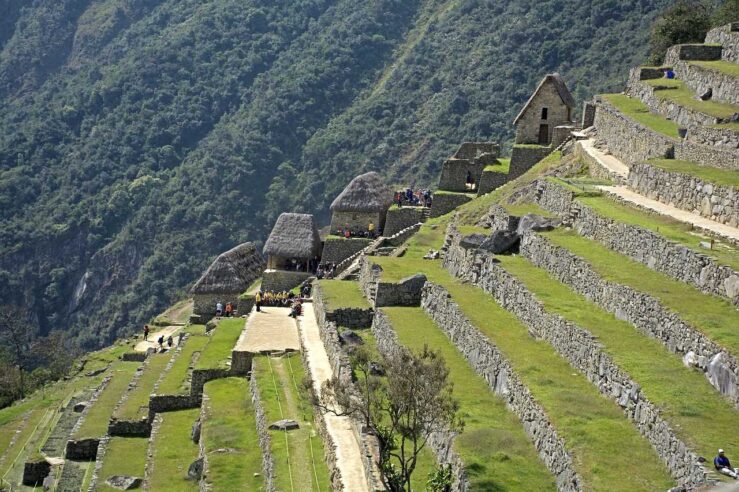
Inca ruins up the Machu Picchu mountain | Photo: Rodrigo Vergara / Pixabay
One of the ancient entrances is the Sun Gate, Inti Punku. For Inka trail hikers the ultimate highlight is to arrive early in the morning to watch it at sunrise. Our guide takes us through the well-preserved ruins and explains about the Inca culture and the significance of the various parts of the ancient Inca settlement. He discloses a lot of interesting details which enrich our picture of the old Inca culture and the Inca way of living.
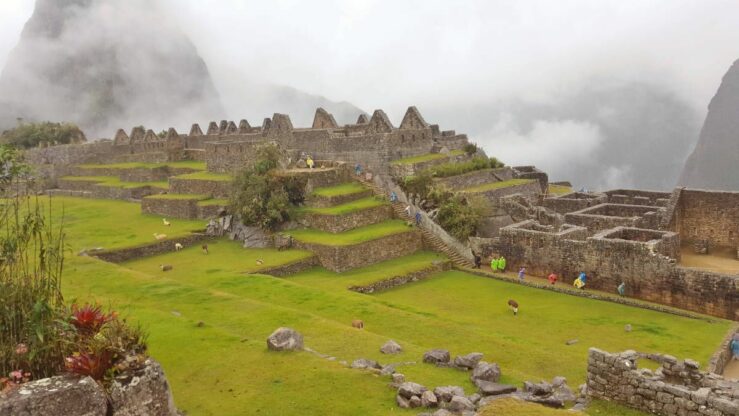
Terraced areas of Machu Picchu with grazing alpacas and llamas | Photo: Travel In Culture
The complex has had considerable astronomical importance, since several of the constructions and the sun fall in a straight line for summer and winter solstice, respectively. Henry takes us to the ruins of a specific window inside the citadel that the light from the Sun Gate strikes precisely at winter solstice. It is a world of wonders and a mythical universe of the Incas.
He shows us places where the condor has been used as a symbol and a messenger between the gods and the Incas. It is depicted on the rocks together with the snake and the puma. These three animals are subject to several distinct interpretations in the Inca culture. According to one of them they symbolise the underworld, our present world and heaven.
Speaking about animals, the true residents of Machu Picchu today are the photogenic llamas and alpacas appearing among the Inca ruins at moments when we least expect it!
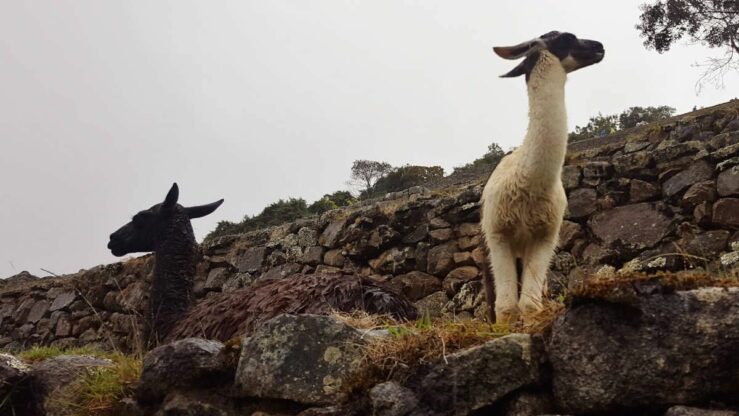
The current residents of the Inca citadel | Photo: Travel In Culture
Back in Aguas Calientes we find a quiet spot opposite our hotel in the upper part of the village where we spend some time watching the exotic and colourful birds in the trees overlooking the river and the rainforest. Before catching the train from Machu Picchu Station and heading back towards Cusco, we just have time for a few purchases on the local market together with Peruvian mothers carrying children on their backs in the typical striped, woven sling. Then we board our train for a 2-hour ride through the lush rainforest back to Ollantaytambo.
In Ollantaytambo a van conveniently picks us up to take us back to Cusco. We now appreciate that everything is just taken care of for us since we are pretty exhausted after two very long sightseeing days climbing ruins! Anyway, our 2-day tour to Machu Picchu and the Sacred Valley has been absolutely worth the trip! We have seen for ourselves why the archaeological site of Machu Picchu with its mystic and mythic Inca culture is one of the New Seven Wonders!
Read next: A Taxi Driver is our Guide to the Galapagos Giant Tortoises
Find useful travel gear: Travel Essentials
Travel Insurance / Visa
Have you considered what you will do in the (unlikely) event of something unforeseen happening? Do you need a travel insurance? Check here if you need a travel insurance for your trip – and check here if you need a visa for your trip and apply for it!
‘See the Mythic Inca Culture on Machu Picchu Mountain’
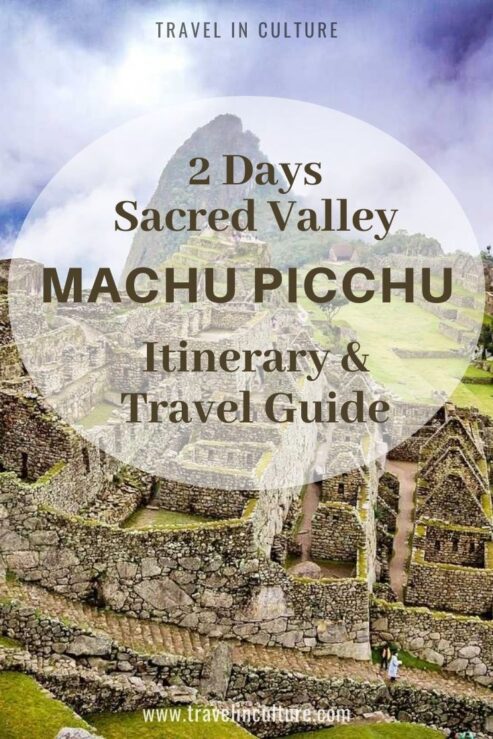
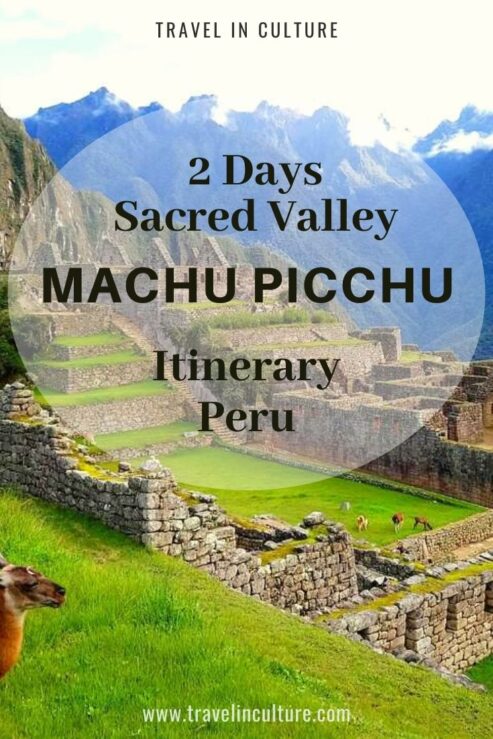
Featured image of
See the Mythic Machu Picchu Culture on the Inca Mountain:
Poswiecie / Pixabay


